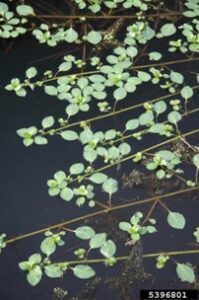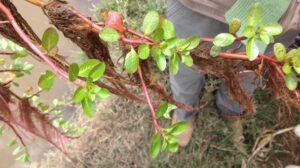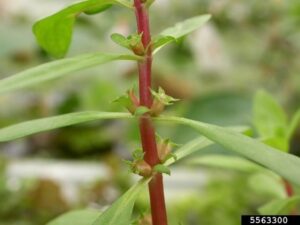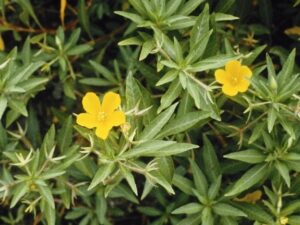Floating Primrose-Willow (Ludwigia peploides)

Floating Primrose-Willow
Photo Credit: Vern Wilkins, Indiana University, Bugwood.org
Common Names: Floating primrose-willow, creeping water primrose, water primrose, primrose willow
Latin Name: Ludwigia peploides
French Common Name: jussie à grandes fleurs, ludwigie à grandes fleurs
Order: Myrtales
Family: Onagraceae
Did you know? Floating primrose-willow can double its size in as little as 15 days when in optimal conditions.
Floating primrose-willow is a perennial aquatic plant native to South America, Central America, and the Southeastern United States. It is considered invasive in Northern U.S. and Canada, however, there are not yet known populations in Canada. Though not yet present in Canada, floating primrose-willow has the potential to suppress the growth of Canada’s native aquatic plants through its spread, causing a decrease in biodiversity and substantial impacts on whole ecosystems.
Floating primrose-willow is often spread through the gardening and aqua-scaping trade as an ornamental plant. When the plant is released into the wild, it can take over whole ecosystems, choking out native plants, invertebrates, reptiles, and amphibians, who rely on a healthy ecosystem to survive.
Floating primrose-willow is a perennial, herbaceous aquatic plant that spreads horizontally across the water’s surface. Plants can be a few meters long vertically and can span many meters horizontally, forming a thick mat across the water. Plants can grow to be as tall as 80cm above the water, and 3m below the water.

Leaves:
Leaves are green in colour, smooth, and have petioles which are the stems that attach the leaf to the main stem. The leaves are arranged in an alternate pattern. The shapes of the leaves can be one of two shapes. Early growth leaves are rounder in shape, while older growth leaves are longer ovals. Leaves are less than 10cm long. Leaves can be hairless or can have short hairs.

Flowers:
Flowers are a striking yellow, with five petals that are 7 to 24mm long. Flowers bloom from July through October. Flowers occur solitary, rather than in bunches.

Stems:
Stems may be smooth or have short hairs. Their length can vary between 10 to 300 cm, depending on their growth stage. Stems are brown to red-ish in colour.

Roots:
Floating primrose-willow has two root types. The adventitious roots are roots that form at the nodes on the stem, spreading horizontally outward rather than vertically downward. These roots are for oxygen uptake. The other type of roots are attached downward into the substrate.

Similar Plants
Water purslane
Ludwigia palustris
Green flowers and opposite arranged leaves.

Water primrose
Ludwigia hexapetala
More upright flower stems. Very similar to L. peploides.

Floating primrose-willow is a perennial plant which means it can live for several years. Plants are spread through both seed and vegetative propagation and seeds are dispersed through water currents. Stems can also be dispersed through water currents or by attaching to nearby objects such as wildlife, swimmers, or boaters, and can grow in a new area once deposited. This plant can grow rapidly, especially in nutrient-rich waters with high access to sunlight (Gillard et al., 2017).
Much of the growth of floating primrose-willow occurs in the spring to summer, with plant leaves reaching the water surface by early spring. Flowers bloom from July through October. Stems, leaves, and flowers fall off during the autumn months, and the plant becomes mainly dormant during the winter with little to no seed or flower production.
Floating primrose-willow has the capacity to grow in both wet terrestrial areas, as well as in freshwater aquatic areas (Gérard et al., 2014). Given its hardiness, this plant can grow in man-made, poorer environmental conditions such as dams, trenches, ditches, and canals. The ideal habitat for this plant is in 2-3m deep water, with little to no current, such as marshes, ponds, slow-moving rivers, and shorelines (Zotos et al., 2006). Typically, the plant will begin its growth on the water’s bank and extend out horizontally into deeper waters (Zotos et al., 2006). Floating primrose-willow can grow in a variety of substrates, including sandy and gravely soils (Zotos et al., 2006).
Warmer temperatures above 10°C is preferred. Floating primrose-willow can tolerate both wet and dry climates, however, it will spread easier under wet conditions. It is relatively tolerant to frost, although may not be able to survive Canada’s cold and long winters.
Floating primrose-willow is found globally, and has made its way to several continents, including Africa, Europe, Australia, Asia, and North and South America. This plant has not yet been observed in the wild in Canada, but is being closely monitored, as it has the potential to spread from bordering U.S. states.

Within the United States, floating primrose-willow has spread from its native range in the Southern states, up to central, Western, and Eastern states. Many of these states border Canada, and it is therefore important to report sightings of this plant to EDDMapS.

Ecological Impacts:
Floating primrose-willow has the ability to significantly alter the chemistry of its ecosystems. It can lower oxygen and other valuable nutrients, while increasing harmful chemicals in the waterbody. This plant chokes out native plants, as well as the other organisms that rely on a healthy ecosystem to survive.
The way in which floating primrose-willow spreads out on the water’s surface also shades other aquatic plants located under the surface. By taking up all available sunlight, plants located below the surface will die off without this essential requirement for life.
Floating primrose-willow has the potential to take over whole ecosystems, outcompeting and displacing native plants, while making the ecosystem uninhabitable for organisms that rely on it.
Social and Economic Impacts:
Floating primrose-willow’s growth pattern across the water’s surface creates a barrier for swimmers and boaters. This plant has the potential to wrap itself around motors and swimmers, causing significant obstacles to recreational waterbody use. Also, due to its ecological impacts, this plant can cause the waterbody to become uninhabitable to native fishes, causing the water to be unusable for recreational fishing or aquacultural use.
Due to its ability to double its biomass in as little as 15 days, floating primrose-willow also has the potential to cause severe blockages in natural drainage, irrigation, and water currents. If located in irrigation channels or ditches, this plant can cause flooding, sedimentation, and silting.
The floating primrose-willow can severely change the chemical make-up of waterbodies, including lowering the oxygen levels, lowering sulphate and nitrate, and increasing phosphate and sulphide. This leads to an uninhabitable ecosystem for native plants and has the potential to kill off native seedlings before they’re even able to sprout. The main sign of floating primrose-willow in a waterbody is therefore the sudden decrease in native plant growth, and ultimately the growing monoculture of just floating primrose-willow plants taking over the ecosystem.
Floating primrose-willow is being proposed as a restricted invasive species under the Invasive Species Act of Ontario. Restricted invasive species cannot be released or enter a conservation reserve or provincial park in Ontario.
Currently, no other Canadian provinces or territories recognize, restrict, or prohibit floating primrose-willow as a problematic invasive plant. Without regulation, there is a higher likelihood of Canada’s ecosystems being damaged by this plant.
How You Can Help
In the case of species identification, a useful resource for reporting a sighting is EDDMapS (https://www.eddmaps.org/). This user-friendly resource allows community members to report sightings of invasive species that are then confirmed by trained taxonomists who will identify the species via pictures from community members. This resource is accessible to anyone who wants to know what invasive species may be present in their area.
Remember to never let your pets or other at-home species loose! If you own an aquarium or other house plants, make sure you are consulting proper disposal guidelines for water and living plants. DON’T LET IT LOOSE!
Articles and Research
Gérard, J., Brion, N., & Triest, L. (2014). Effect of water column phosphorus reduction on competitive outcome and traits of Ludwigia grandiflora and L. peploides, invasive species in Europe. Aquatic Invasions, 9(2).
Zotos, A., & Sarika, M. (2006). Ludwigia peploides subsp. montevidensis. Journal of Biological Research, 5, 71-78.
Gillard, M., Grewell, B. J., Futrell, C. J., Deleu, C., & Thiébaut, G. (2017). Germination and seedling growth of water primroses: a cross experiment between two invaded ranges with contrasting climates. Frontiers in Plant Science, 8, 1677.
Resources
Washington State Noxious Weed Control Board: https://www.nwcb.wa.gov/weeds/floating-primrose-willow
Michigan Invasive Species: https://www.michigan.gov/invasives/id-report/plants/aquatic/water-primrose
iNaturalist Canada: https://inaturalist.ca/taxa/50339-Ludwigia
United States Geological Survey: https://warcapps.usgs.gov/PlantID/Species/Details/1687
Invasive Plant Atlas of the United States: https://www.invasiveplantatlas.org/subject.html?sub=5962
CABI Digital Library: https://www.cabidigitallibrary.org/doi/10.1079/cabicompendium.31673
Washington King County: https://kingcounty.gov/en/legacy/services/environment/animals-and-plants/noxious-weeds/weed-identification/floating-primrose-willow
Further Reading
Government of Ontario proposed prohibited invasive species: https://www.ontario.ca/page/new-invasive-species-proposed-regulation-under-invasive-species-act
